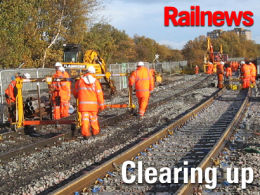Posted 13th February 2014 | 5 Comments
Lines restored after 'immense effort' to repair damage

THE overnight storms left many parts of the railway network disrupted on Thursday morning, with lines blocked by fallen trees, damaged overhead wires or floods.
Network Rail said 'immense efforts by hundreds of rail engineers overnight' had seen scores of trees removed from blocked lines, over a dozen dewirements repaired and hundreds of pieces of debris cleared away
The most extreme parts of the storm hit Wales and north west England, and the West Coast Main Line was closed for some distance north of Preston for a time. Network Rail said most of the West Coast line was open again with only the spur through Runcorn to Liverpool still closed. This was expected to be restored later in the morning.
The majority of the East Coast Main Line was also open with the spur from Doncaster to Leeds expected to reopen during the morning. Overhead line damage north of York meant only a limited service could be provided as work continued to repair damage. A blanket speed restriction of 80mph from Newcastle to the Scottish border was expected to add about 30 mins to Anglo-Scottish journey times until midday.
Crewe station, which was closed last night because of wind damage to the roof and overhead wires, has now reopened, but delays are continuing on a number of other lines in the north of England. In Wales, engineers were also continuing to clear lines, and there were no train services on Thursday morning between Clarbeston Road-Fishguard Harbour, Llandudno Junction-Blaenau Ffestiniog and Machynlleth-Aberystwyth.
Flooding in the south and west of England has continued to disrupt the third rail network south of London where several lines remain closed, while obstructions also continue at Dawlish and Bridgwater. At Maidenhead the Great Western Main Line is open but train services are restricted by flood-damaged signalling equipment. Flooding at Hinksey on the outskirts of Oxford has now retreated, but Network Rail said it was only possible to provide a half-hourly shuttle between Oxford and Reading because of the problems at Maidenhead.
Today marks a welcome break in the disruptive weather for many, but forecasters are warning of more rain and wind tomorrow.
Reader Comments:
Views expressed in submitted comments are that of the author, and not necessarily shared by Railnews.

John Gilbert, Cradley
It would be an excelle nt idea to find out from European railways how reliable their catenary is. After all, countries such as Switzerland and the Nordic lands get extreme weather conditions frequently, and the Swiss have had electric railways for some 100 years. Is this yet another case of Britain refusing to learn from others - in this case Europeans with vast experience of electrification?
To this might be added the unpopularity here of headspan construction, seemingly solely since the under-specified ECML catenary tends to fall off the insulators as soon as the wind rises above the strength of a zephyr! Yet headspan construction is also to be seen all over Europe - e.g. in Germany to name only one country.
Chris Hamilton, Carluke, South Lanarkshire
All trains are a little unstable in high winds, though it's not normally a problem, but the speed restrictions tend to be because we don't want trains and trees meeting at 125mph.
The reason that HS1 and TGV lines don't have that problem is there tends to be a lot less trees and the wires are more resilient due to their higher tension The WCML is almost a green tunnel of trees and the wires flap in the wind.
Garth Ponsonby, Dunkeld
Tony,
I suspect it is more to do with the distinctly ordinary (= cheap) standards adopted by BR at the insistence of HM Treasury when the lines were first wired. Modern installations are much more substantial, and can resist high winds much better.
Chris Neville-Smith, Durham, England
Tony Pearce, as I understand it, it's nothing to do with HS1 being a high-speed line. The advantage of both HS1 and the French LGVs is that they were designed to be resilient from these weather conditions, whilst in Victorian days, the fact that you could get from A to B at all was considered good enough.
In theory, I guess you could make all lines as resilient as HS1 if you rebuilt them from scratch. But that would mean closure of main lines for months, maybe years. I cannot imagine anyone considering that a price worth paying - at least, not on the UK network where there's no suitable long-term diversionary routes.
Tony Pearce, Reading
When I heard about the lines closing because of possible overhead wire problems and excessive winds, I wondered how HS2 trains might fare in the future in such conditions. I did not hear of HS1 being closed and neither have I ever heard of the French TGV being stopped because of high winds. Was it because the Pendolinos tilt and does that make them unstable in strong winds ?